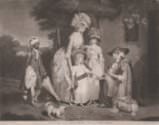Woman Holding a Mask
Woman Holding a Mask
between 1795 and 1800
John Raphael Smith
1752-1812
Pastel on medium, moderately textured, wove paper
13 1/4 × 10 1/2 inches (33.7 × 26.7 cm)
This young woman is dressed for a masquerade. Over her white dress is a black “domino,” or voluminous hooded cape. She holds a mask that bears the stereotyped features of a black man or woman with conspicuously pink lips and cheeks. When the mask was pressed to her face, and the hood was up, the woman’s identity would be completely disguised. As fashionable fancy-dress entertainments, masquerades reached the height of their popularity in Britain in the 1770s and 1780s. Guests wore costumes that transgressed boundaries of gender, culture, class, and—as in this instance—race. Sometimes white men and women attended as “blackamoors” or Africans. In 1770, one man was seen “in the character of Mungo.”
John Raphael Smith—who also published the paired antislavery prints displayed in the previous room—established a reputation for his female genre subjects, including depictions of actresses and prostitutes, which he exhibited at the Royal Academy and published as prints. By the 1790s he was also advertising “portraits in crayons” (i.e., pastels). Whether this pastel was intended as a portrait or a more generic image, it staged feminine whiteness through the juxtaposition of its perceived opposite. It did so at a moment when new biological theories of human difference were laying foundations for the scientific racism that would underpin colonialism and social inequality in the nineteenth century and beyond.
B1977.14.6285
Yale Center for British Art, Paul Mellon Collection


